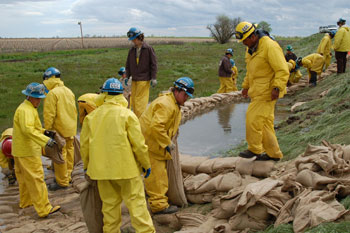Storms, quakes and creeping saltwater intrusion could all spell trouble at the tap

In the conclusion of her three part series, “California’s Deadlocked Delta,” KQED science reporter Lauren Sommer explores how climate change will affect the San Francisco Bay-Delta’s already foundering ecosystems and further complicate management of this critical hub of California’s water supply.
For those who know little about the massive estuary an hour east of downtown San Francisco, the Delta is the meeting place of two of the state’s largest river systems, the Sacramento and San Joaquin. Flowing down from Sierra snowfields and lakes, the two rivers converge in this 1600-square-mile tangle of tidal marshes, sloughs and canals.
As California’s population and economy has grown, so has demand for water, much of which is pumped from the Delta and delivered throughout the state by way of sprawling networks of reservoirs, canals and aqueducts. (For more on the Delta’s geography and history, see the interactive map and presentation accompanying the report.)
A key challenge examined in Sommer’s report is the issue of sea level rise, which makes the Delta’s aging and subsiding 1100-mile levee system increasingly vulnerable to flooding and failure.
Rising sea levels make the possibility of damaging storm surges, in which water rushes over the levees, a greater possibility. One scenario, described in a recent post by Climate Watch, says that a concurrent rise in sea level corresponding with a storm surge and high tides could cause sea level rise by as much as four feet in the Bay Area by 2030. The consequences would be disastrous in the Delta. Though well inland, much of the Delta lies well below sea level (due to subsidence caused by the oxidation and subsequent erosion of the region’s characteristic peat soils [PDF]) and its hydrology is intimately connected with that of the Bay.
The threat is magnified by the risk of a major earthquake, which by most accounts the Bay Area is due for. For example, in 2009, the US Geological Survey predicted that there is a 62% chance of a 6.7-magnitude or greater earthquake striking the Bay Area in the period between 2003 and 2032.
“It depends on where the earthquake occurs, how intense it is and how that energy moves through the Delta,” says Jeff Mount, a geosciences professor at the University of California at Davis. He explains that earthquakes threaten the Delta’s levees in one of two ways, by damaging their internal structure or by undermining the sands and peat soils under them.
[module align=”left” width=”half” type=”pull-quote”]“We have to come up with solutions, otherwise events will decide them for us – and that almost never works out well.”[/module]
A levee failure could result in a rush of saltwater into the Delta, a scenario sometimes referred to as the “big gulp.” A recent report by the National Academies of Science [PDF] stated that saltwater intrusion – by way of a major levee breach, or the steady creep of saltwater from rising ocean levels – could result in a decline in the volume of water available for irrigation and drinking water by as much as 25% by the end of the century. “We’re in a race to mitigate all those risks. But we have one small problem – it’s hugely expensive,” Mount explains. “The existing bonds that have already been authorized are insufficient to really tackle this.”
But, as Mount concluded, the costs of not taking action on the Delta’s problems are unquestionably larger. “It’s the hub of California’s water supply and it’s the weak link in the chain,” says Mount. “We have to come up with solutions, otherwise events will decide them for us – and that almost never works out well.”
Part three of the “Deadlocked Delta” series airs Monday morning on KQED 88.5. The entire series, including exclusive web features, is archived at the QUEST site.
4 thoughts on “Three Delta Disasters that Could Disrupt California’s Water Supply”
Comments are closed.

I am not so much concerned about the threat of the major earthquake as I am about the lack of preparation for sea level rise and it’s ensuing impacts… primarily salt water intrusion as you state. In the long run, not even Netherlands scale dikes will be enough to keep salt water away from those big pumps. The propaganda being handed out by the Brown Administration would be laughable were the consequences of following his agenda no so dire.
The Delta is a disaster waiting to happen. Central Valley and Southern California water agencies should focus more on water conservation and reuse instead of trying to find way to grab even more water from Northern California via the Delta. With effective water conservation
and recycling, we could live without taking anymore Delta water.
Pleeeaaase – The State’s Farmers are being blackmailed and their water turned off – This is a scheme to take over every facet of CA and turn all food into GMO food – Climate Change is a hoax by the Al Gore and the Eliteist gang – follow the money.
Between the extremists on both side forget about a solution. Pat Brown where are you?